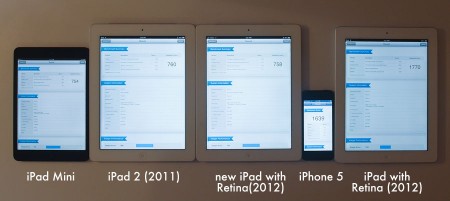When Apple announced the iPad Mini last week, it was pretty much the tablet most people expected it to be. A seven incher with a thin body and Lightning port, we all saw it coming. But the revamped 9.7 inch iPad with Retina screen? This was more of a surprise, and while it looked pretty similar from the outside, we decided to give it a test to see just how the 4th generation iPad compares to the current model.
Arriving in stores later this week in Wi-Fi-only guise, with the 4G/LTE varieties to hit in late-November, the iPad 4 – or rather ‘iPad with Retina screen’ – will replace the 3rd generation iPad entirely, which itself has only been on sale since March this year.
Normally, Apple pushes its older stock down to second position, offering an iDevice for a cheaper price even though it’s a generation old. Not so with the iPad 3, which is definitely gone, while the second-generation iPad from 2011 retains the less-expensive entry-point slot.
And after doing some testing of the fourth-generation iPad, though, we think we know why Apple has been so keen to update its current model.

We ran a selection of Apple iPad products, starting with the iPad 2 through our suite of testing software, and found that the third-generation iPad – the first iPad with a Retina screen – performs closer to the iPad 2, which is likely due to the older generation A5X processor powering it. This processor is a revamped version of the A5 processor, albeit with quad core graphics, found in the second-generation iPad from 2011.
One benchmark, for instance, shows the new 4th generation iPad with Retina outpacing the model from earlier this year by over 200 percent, showing that it really has the guts to take on new processor and graphics intensive games and apps. The iPhone 5 is equally impressive, but with a less resolution-heavy screen, doesn’t need as much horsepower. The key ingredient in both the iPhone 5 and the new iPad is Apple’s latest generation A6 and A6X processors.
In a computational speed test, the fourth-gen iPad outpaces its third-gen brother with even more margin, completing its test in a quarter of the time needed for the model released earlier this year.
While these tests don’t have as much in common with real world activities, they do show just how blazingly fast the new iPad is, and should help it to dominate the tablet market for at least the next year, as app and game developers start to take advantage of the new speed and power available via the A6X processor.
Meanwhile, our benchmarks also showed us something which doesn’t surprise us at all: the iPad Mini is literally a smaller iPad 2.
It has the same screen resolution of 1024 x 768 and similar specs, and the benchmarks practically confirm it, with similar performances in the benchmarks across the board.
The good news with this is that we probably won’t see games and apps that exclude the iPad 2 or iPad Mini in the next year or two, unlike what happened with the original iPad. But if games come out that rely on the raw speed offered by the A6 chips in the iPhone 5 and iPad 4, chances are even the Mini will be left behind eventually.










